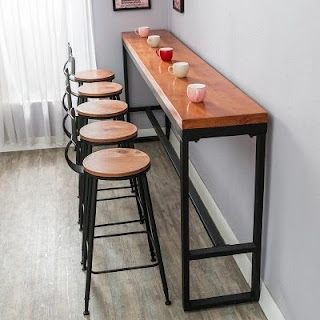Best Wood Types for a Rock-Solid Bar Table
Crafting a bar table isn't just about aesthetics; it's about building a sturdy centerpiece that can withstand years of lively gatherings. The right wood makes all the difference. Choosing wisely ensures your creation not only looks stunning but also endures countless drinks, spirited conversations, and the occasional accidental spill. This guide explores the best wood types to guarantee your bar table stands the test of time, becoming a cherished part of your home.
Hardwoods: The Heavy Hitters
Hardwoods reign supreme for bar tables due to their inherent strength and durability. These woods boast a higher density, making them resistant to dents, scratches, and everyday wear and tear. However, their density also makes them more challenging to work with, often requiring more specialized tools and experience. The higher upfront cost is easily justified by their longevity and impressive appearance.
Oak: A Classic Choice
Oak, a timeless classic, offers exceptional strength and durability. Its tight grain and resistance to moisture make it ideal for high-traffic areas. You'll find a variety of oak species, each with unique characteristics: red oak boasts a warm reddish-brown hue, while white oak presents a more subtle, creamy tone. Both offer excellent workability and a beautiful grain pattern that adds character to any bar table.
Maple: Sleek and Strong
Maple provides a stunning, clean aesthetic, prized for its fine, even grain and light coloration. Its density ensures exceptional durability, resisting dents and scratches remarkably well. Hard maple is especially favored for its strength and hardness, perfect for enduring the rigors of a busy bar. The natural beauty of maple pairs well with a variety of design styles, from sleek modern to rustic farmhouse.
Walnut: Rich and Luxurious
Walnut is a showstopper, known for its rich, dark brown tones and striking grain patterns. Its strength and durability rival other hardwoods, while its luxurious appearance elevates any space. While potentially more expensive, the beauty and longevity of walnut make it a worthwhile investment for a truly exceptional bar table. The dark color also hides scratches effectively, maintaining its elegance over time.
Softwoods: Budget-Friendly Options with Character
While not as durable as hardwoods, certain softwoods can provide a cost-effective alternative for building a bar table, especially with appropriate finishing and care. They offer distinct aesthetic qualities and are often easier to work with for DIY enthusiasts. However, be mindful that these woods are more susceptible to dents and scratches, requiring careful handling and potentially more frequent maintenance.
Pine: A Versatile Choice
Pine is a readily available and affordable softwood. Its warm, slightly yellowish tone and visible grain add a rustic charm. While softer than hardwoods, proper finishing, such as multiple coats of polyurethane, can significantly enhance its durability. Pine’s forgiving nature makes it a good choice for beginners.
Factors Beyond Wood Type
Remember, the longevity of your bar table isn't solely dependent on the wood. Other factors contribute significantly to its durability:
- Finishing: Apply several coats of a high-quality sealant to protect against spills and scratches.
- Construction: Use robust joinery techniques (like mortise and tenon joints) for maximum stability.
- Maintenance: Regularly clean and condition the wood to preserve its beauty and extend its lifespan.
Ultimately, the best wood for your bar table depends on your budget, aesthetic preferences, and desired level of durability. Carefully consider your needs and the characteristics of each wood type to create a lasting centerpiece for your home.






















